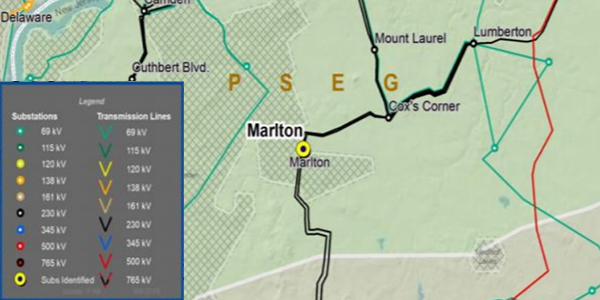VALLEY FORGE, Pa. — The PJM Planning Committee deferred voting again on a problem statement and issue charge for a proposed review of the RTO’s critical infrastructure management.
The second delay follows a plea from Exelon and other transmission owners on Thursday to hold off on the issue until after a webinar scheduled for Friday to address stakeholders’ concerns about a proposed Tariff attachment that creates a process to mitigate existing facilities on NERC’s CIP-014 list. (See “Critical Infrastructure Vote Deferred,” PJM PC/TEAC Briefs: Oct. 17, 2019.)
“A number of things on this issue charge could be removed or modified,” said Pulin Shah, director of transmission strategy and contracts for Exelon. “The M4 [attachment] hasn’t been approved. We are still working through this process. A lot of the things that are in here may or may not even be applicable [after the webinar].”
He clarified that a second 30-day delay would give stakeholders more time to “focus the scope on the areas of concerns that everyone has alignment on in terms of creating new CIP-014 facilities.”
DER Ride Through Task Force Sunset
PJM wants to sunset the Distributed Energy Resources Ride Through Task Force after saying its work considering a default standard is done.
The RTO said distributed energy resources currently function on settings designed to respond to unexpected system malfunctions that disrupt power flow. Some sources “ride through” the event, providing much-needed reliability, while others trip off to prevent system damage. Solar panels and other DERs also can’t tell the difference between a transmission fault and a distribution fault, causing inappropriate responses and overstressing the system.
The task force had been considering ways to fix this problem — even going so far as to bring in federal experts to help develop new standards — but decided against an RTO-wide rule because of the uniqueness of local distribution systems. (See DER Ride Through Task Force Considers New Direction.) Instead, the task force suggested that PJM create a recommendation when a local distribution system lacks an official policy.
Competitive Transmission Proposal Fee Restructuring
As PJM moves forward with its proposed fee restructuring for competitive transmission proposals, stakeholders remain concerned about the associated revisions to Manual 14F required as part of the update.
The revisions, borne out of a stakeholder motion endorsed by the Markets and Reliability Committee last year, will codify the comparative cost framework the RTO will use to evaluate these projects. (See “PJM Unveils Flat Fee Cost-containment Plan,” PJM PC/TEAC Briefs: Aug. 8, 2019.) Since implementation of FERC Order 1000 in 2014, PJM has reviewed 850 competitive proposals, of which less than 20% included cost-commitment provisions.
TOs continue to question the appropriateness of revisions proposed by both PJM and the Independent Market Monitor that would memorialize an ongoing collaborative role between the two entities in reviewing competitive transmission proposals. (See PJM TOs Wary of Cost Containment Rules.)
In an effort to bridge the gap, LS Power proposed a paragraph that would clarify PJM’s precedence over the Monitor in reviewing proposals, a suggestion that fellow TOs found promising but still imperfect.
Some 77% of stakeholders at the PC approved of PJM’s current proposal. PJM’s Mark Sims said staff will take the restructured fee and its associated Operating Agreement and manual changes to the MRC for endorsement next month.
Manual 19 Revisions Endorsed
Stakeholders endorsed revisions to Manual 19: Load Forecasting and Analysis, a periodic cover-to-cover review that also removes load forecast model overview from the manual and adds it to an annual white paper. The revisions also update sections 3.2, 3.4 and 4.2 to update the weather-normalization procedure for peak load and energy to be directly tied to the load forecast model.
Supplementals from AEP, ComEd, Dominion, PSE&G
American Electric Power wants to replace 18 remaining ELF-SL8-4 Type SF6 breakers at its Sullivan 765/345-kV and Rockport 765-kV substations in Rockport, Ind., after documenting more than 16 issues, including compressor failures, since 2002.
Commonwealth Edison proposed a $200,000 rebuild of its Quad Cities-Cordova 345-kV line to fix obsolete relays and servicing difficulties. The line is an intertie between PJM and MISO and needs the upgrade to address equipment condition, performance and risk.
A second ComEd project to rebuild 16 miles of the 345-kV Kendall-Lockport double-circuit towers, increase the line rating and eliminate 10.5 miles of wood poles that are 60 years old will cost $12 million, Exelon said. The utility considered two other $20 million solutions as part of its review process but instead settled on a cheaper plan to install quad-circuit towers between the Kendall and Lockport substations, string 138-kV conductor and cut part of line 9117 over new towers.
Dominion Energy wants to spend $69 million to preserve its remaining outdoor equipment at the Mt. Storm substation in West Virginia. The utility proposes installing a second gas-insulated substation (GIS) building in the switchyard to house the breakers and switches for Lines 550 and 536 and two generators. The existing GIS building would be expanded to include breakers and switches for lines 529, 572 and Capbank 3.
The company also presented a $400,000 plan to install a 1,200-ampere, 50-kAIC circuit switcher and associated equipment to feed a new transformer at Poland Road.
Finally, Public Service Electric and Gas proposed a $39 million plan to build a new 230-kV substation in Echelon, N.J., to alleviate the overloaded Marlton substation nearby. The utility also considered building a $68 million 69/13-kV substation but decided on the less expensive proposal because it decreases the amount of exposure and increases the reliability of the 230-kV circuit.




